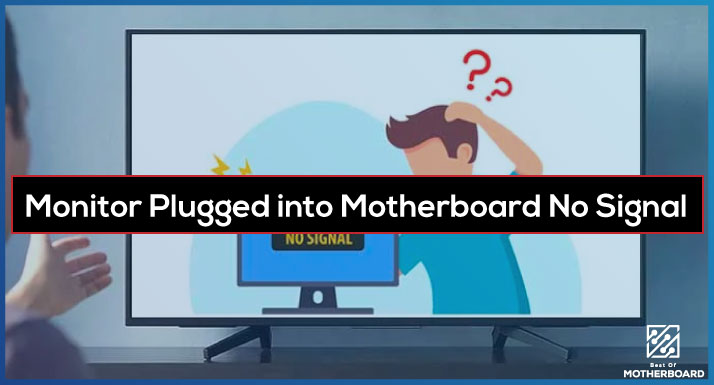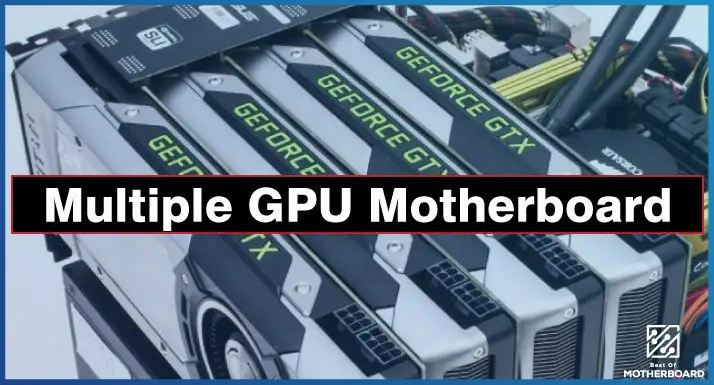Different problems can arise with your computer. When it arises, it can make you feel very infuriated and frustrated as no one likes it whenever their device develops a fault.
It may be from not booting to the external components not functioning well to the system working slowly or lagging when in use. In this section, we’re going to be talking about one common problem people encounter with their computers which their monitors are showing no signal despite being plugged into their motherboards.
Monitor Plugged into Motherboard No Signal – Solutions
Like every other electrical device that occasionally develops a fault, computers also develop faults from time to time and when it develops a fault, it’s up to you to figure out ways by which you can solve this problem and get your system back to working in a perfect condition.
The monitor displaying no signal is a common problem most individuals that use a computer encounter from time to time. There are different reasons why your monitor could be displaying a no signal on the screen despite it being plugged into your motherboard.
Follow me as I explain the possible reasons and solutions on how to fix the problem.
1. Loosed or faulty cables
This is one of the major reasons why most monitors display a no signal when you turn it on. When you turn your monitor on, if the cables are faulty or bad, there is a chance transmission won’t occur from your CPU to your monitor. Also, if you have loose or badly connected cables, there won’t be any transmission on your monitor.
If your monitor is displaying a no signal because of a faulty or bad cable, then there are two choices you can make. You can either send the cables for repairs or you can change the cables entirely.
On the other hand, if it is because of a loose or wrong connection, simply ensure the cable wires are connected to the right ports on the motherboard.
2. Poorly configured display
This can be another reason why there’s a no signal display on your monitor. If the graphics card resolution is higher than the capacity of your monitor, it will very much likely result in no signal display on your monitor. A poorly configured display resolution can also affect the capacity of your monitor
Fixing this problem is relatively easy. You can try a quick fix by simply rebooting your system in a safe mood. When you reboot, the system should automatically start at a low resolution. You can then adjust the display settings using the following steps.
- Go to your window settings
- Click on system
- Click on display resolution
- A pop-up will appear asking if you want to save this setting. Click on save settings.
These are the simple steps you need to adjust the poor configuration that is affecting the display on your screen
Related: Does it Matter Which Sata Port You Use
3. Hardware problem
This is the reason why most people’s monitors display no signal on their screen despite being connected to the motherboard. If there’s a hardware problem, there’s a pretty high chance it would affect the transmission from your motherboard to your monitor. A hardware problem could be the reason why your screen is displaying a “no signal”
Fixing your hardware problem if there’s any shouldn’t be a complicated task for you. Before you begin troubleshooting the computer, make sure it is off and lose all the components. Then check each component to ascertain if there’s any fault anywhere. If there’s any faulty component, do well to change or repair it.
Also, ensure that none of the internal components is loose. If they are, you’ll have to make sure they are properly fitted into the board. Then most importantly, check the graphics card to ensure it is in perfect condition.
If all the components are good and properly connected, the no signal display on your monitor should disappear when you assemble the parts and boot your system.
There are a lot of questions people have when it comes to computers.
“Can a motherboard cause no signal? Can the power supply cause no signal to the motherboard?” You might ask.
Related: What is Game Boost MSI
Frequently Asked Questions – (FAQs)
Can a motherboard cause no signal?
This is one question most people have when it comes to motherboards and displays. It is very much possible for a motherboard to cause a no signal. This is often due to the defective caps on the motherboard.
A bad ram or video card on your motherboard can also cause a no signal display on your monitor. The fault is less likely to come from your monitor.
Can the power supply cause no signal to monitor?
This is also another question people have when it comes to monitors and power supply. The inadequate power supply can affect the CPU or the graphics card which will, in turn, result in your monitor displays being rendered inconsistently.
Also, if the power supply isn’t sufficient for on-screen graphics, the graphics cards may turn the monitor off. The power supply can cause a no signal to your monitor.
Can my CPU cause a no display?
This is also another question a lot of people tend to ask. If your computer has a bad CPU, it will not go through the usual boot up when you switch it on.
You might hear some components and the fan running but, likely, your screen will remain blank. The light on your screen may appear immediately when you turn the monitor on but it will still very much likely result in a no signal display.
Conclusion
In conclusion, different things can cause your screen to show a “no signal” when you turn it on. All you need to do is follow the possible solution given above and your no signal problem should clear in no time.



![What Are Motherboard Standoffs? [Guide] 4 What Are Motherboard Standoffs](https://bestofmotherboard.com/wp-content/uploads/2022/01/What-Are-Motherboard-Standoffs.jpg)
![Does it Matter Which PCIe x16 slot I Use? [Guide] 5 Does it Matter Which PCIe x16 slot I Use](https://bestofmotherboard.com/wp-content/uploads/2022/01/Does-it-Matter-Which-PCIe-x16-slot-I-Use.jpg)